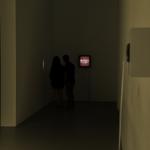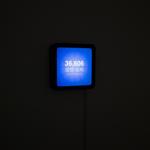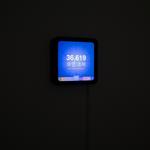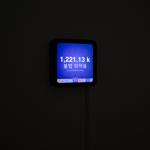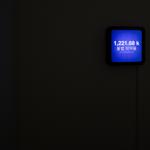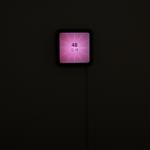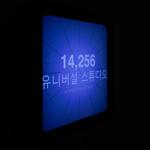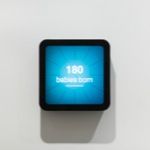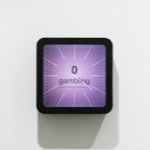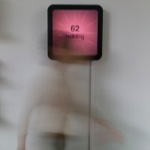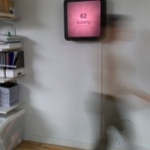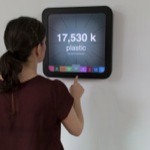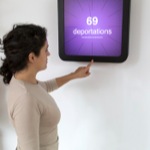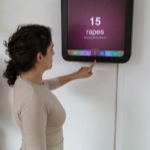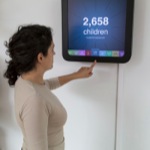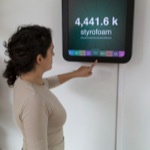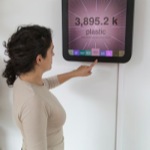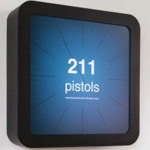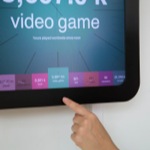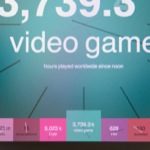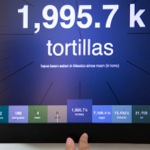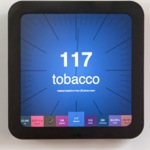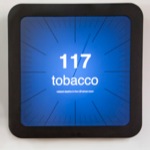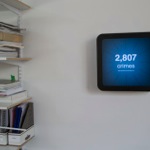Zero Noon
"Zero Noon" is a digital clock that shows the current time according to eccentric metrics: it uses hundreds of different reference systems. For example, the clock can tell the time based on the average number of daily financial transactions in Brazil, or the average daily amount of cookies sold by girl scouts, or the number of animal species that become extinct per day, or the daily average number of breaths that a typical human takes, and so on. Basically, Zero Noon is a clock that is run by internet-refreshed statistics.
The clock's statistics are all synchronized so that precisely at noon they all zero and start over. At noon automatically a new metric is displayed in a different colour chosen from a determined palette. The public may also change the statistics by manually scrolling through the list using small push-buttons under the built-in display. This guarantees that the content of the clocks is always fresh and thought-provoking. The statistics come from government data, Harper’s Magazine, financial institutions, NGOs, academic studies and other trusted sources. Some of the data streams will be useful, others sobering, some of them fun. The actual metrics are chosen by the artist studio but the collector is also able to add statistics to the system.
The clock is in a matte black aluminum frame with rounded corners measuring approximately 45 x 45 x 11 cm deep. The display is an antireflective 39cm x 39cm surface that produces 450 to 500 nits of brightness, suitable for broad daylight. The clock weighs approximately 9 kg and should be hung with its centre 150 cm from the ground.
A clock shows a large number, readable from far away: as you get closer you can read on the bottom the "fine-print" which is the actual reference baseline for that clock, e.g. the average daily number of births in the world. Each statistic is also cross-referenced with the source of the data.
The clock generates a faint "ticking" sound every time that the handle passes noon. For some statistics this ticking will be very sporadic whereas for others it will be very frequent. The volume will be set so low that only someone within 3 feet of a clock will be able to hear it.
Inside the clock is a square display, and a computer that may be connected to the internet to manage content, timing, and other settings.
The piece exists as a single unit in edition of 12+2AP. And in a unique installation with 18 or more coordinated synchronized displays.
The clock's statistics are all synchronized so that precisely at noon they all zero and start over. At noon automatically a new metric is displayed in a different colour chosen from a determined palette. The public may also change the statistics by manually scrolling through the list using small push-buttons under the built-in display. This guarantees that the content of the clocks is always fresh and thought-provoking. The statistics come from government data, Harper’s Magazine, financial institutions, NGOs, academic studies and other trusted sources. Some of the data streams will be useful, others sobering, some of them fun. The actual metrics are chosen by the artist studio but the collector is also able to add statistics to the system.
The clock is in a matte black aluminum frame with rounded corners measuring approximately 45 x 45 x 11 cm deep. The display is an antireflective 39cm x 39cm surface that produces 450 to 500 nits of brightness, suitable for broad daylight. The clock weighs approximately 9 kg and should be hung with its centre 150 cm from the ground.
A clock shows a large number, readable from far away: as you get closer you can read on the bottom the "fine-print" which is the actual reference baseline for that clock, e.g. the average daily number of births in the world. Each statistic is also cross-referenced with the source of the data.
The clock generates a faint "ticking" sound every time that the handle passes noon. For some statistics this ticking will be very sporadic whereas for others it will be very frequent. The volume will be set so low that only someone within 3 feet of a clock will be able to hear it.
Inside the clock is a square display, and a computer that may be connected to the internet to manage content, timing, and other settings.
The piece exists as a single unit in edition of 12+2AP. And in a unique installation with 18 or more coordinated synchronized displays.
General info
Spanish name:
Cero al mediodía
Year of creation:
2013
Single clock version
Technique:
Computer, processing software, square HD display, electronics, metal enclosure
Dimensions:
43 x 43 x 10 cm
Edition:
12 Editions, 2 AP
Collectors:
21c Museum, Fondation Giverny pour l’art contemporain, San Francisco Museum of Modern Art and private collectors
Multiple clocks installation
Exhibitions
- Truth or Dare: A Reality Show, 21c Museum, Chicago, Illinois, United States, 2025 - 2026.
- Rafael Lozano-Hemmer: Decision Forest, Amorepacific Museum of Art, Seoul, South Korea, 2018.
- Seeing Now, 21c Museum, Nashville, Tennessee, United States, 2018 - 2019.
- Anthology - Monumental Works from the Collection, Arsenal Art Contemporain, Montréal, Québec, Canada, 2017 - 2018.
- Rafael Lozano-Hemmer: Transition States, Gund Gallery, Gambier, Ohio, United States, 2016 - 2017.
- Real Time, Arts Santa Mònica, Barcelona, Spain, 2016.
- Big Bang Data, Somerset House, London, United Kingdom, 2015 - 2016.
- Seeing Now, 21c Museum, Durham, United Kingdom, 2015 - 2016.
- E-Merge, C2 Montréal, Arsenal Art Contemporain, Montréal, Québec, Canada, 2015.
- Poetics and Politics of Data, Haus der elektronischen Künste Basel, Basel, Switzerland, 2015.
- C2 Conference+Creativity, Arsenal Art Contemporain, Montréal, Québec, Canada, 2015.
- Zero Noon, Fidelity Investments HQ, Boston, Massachusetts, United States, 2014.
- Seeing Now, 21c Museum, Louisville, Kentucky, United States, 2014 - 2015.
- Art Brussels, Carroll / Fletcher Gallery, Galería Max Estrella, Brussels, Belgium, 2014.
- //the_ART_of_DATA, Boulder Museum of Contemporary Art, Boulder, Colorado, United States, 2014.
- ARCO '14, Galería Max Estrella, Carroll / Fletcher Gallery, Madrid, Spain, 2014.
- ZONAMACO, Galería OMR, Galería Max Estrella, Mexico City, México, 2014.
- Art Basel Miami Beach, Galería OMR, Miami, Florida, United States, 2013.
- Aspen Ideas Festival, Resnick Art Gallery, Aspen, Colorado, United States, 2013.
Credits
- Programming: Guillaume Tremblay
- Hardware: Guillaume Tremblay
- Production Assistance: Julie Bourgeois, Pierre Fournier, Claudia Espinosa, Carolina Murillo-Morales, Karine Charbonneau
Bibliography
- "Rafael Lozano-Hemmer PG." Prepared Guitar, 13 Jan. 2015. Madrid, Spain, 2015. (english) (Websites)
- Bosco, Roberta. "Obras en tiempo real para tiempos convulsos." El País, 27 Mar. 2016. Madrid, Spain, 2016. (español) (Newspapers)
- Hirshberg, Peter. "The Art of Data." Huffington Post, 1 July 2013. Canada, 2013. (english) (Newspapers)
- Johnson, Paddy. "Hotel art that makes you feel richer: on 21c in Durham." Art F City, 6 Nov. 2015. New York City, New York, United States, 2016. (english) (Websites)
- Quirk, Justin. "A new show in Basel questions art in a date-driven age." Artphaire - Park Hyatt, 23 June 2015. United States, 2015. (english) (Magazines)
- Robin. "Big Bang Data." Talking Beautiful Stuff, 3 Mar. 2016. 2016. (english) (Websites)
 Rosamond, Emily. "Rafael Lozano-Hemmer: Obra Sonora." Esse Arts+Opinions Magazine, 1 Jan. 2015. Montréal, Québec, Canada, 2015. (english and français) (Magazines)
Rosamond, Emily. "Rafael Lozano-Hemmer: Obra Sonora." Esse Arts+Opinions Magazine, 1 Jan. 2015. Montréal, Québec, Canada, 2015. (english and français) (Magazines)- Saux, Frances. "Rafael Lozano-Hemmer's show turns its gaze on the viewer." The Kenyon Collegian, 13 Oct. 2016. Gambier, Ohio, United States, 2016. (english) (Websites)
- Silver, Leigh. "50 Must-See Art Pieces at Art Basel Miami Beach 2013." Complexmag, 6 Dec. 2013. Canada, 2014. (english) (Websites)
Photo Library (click to expand)
